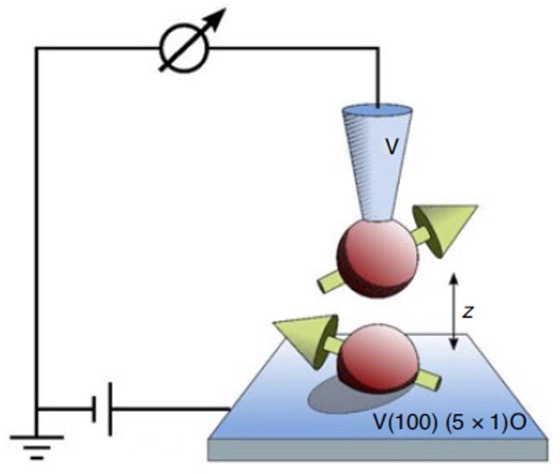Tunneling between superconducting bound states
27/07/20 19:19
The competition between magnetism and superconductivity is one of the most fundamental problems in condensed matter physics. The ability of the scanning tunneling microscope (STM) to manipulate individual magnetic atoms and molecules has enabled to study this competition at the atomic scale. An interesting manifestation of the interplay between these two phases of matter is the appearance of the so-called Yu-Shiba-Rusinov (YSR) bound states in the spectrum of a single magnetic impurity coupled to a superconductor. Numerous STM experiments on single magnetic impurities on surfaces of conventional superconductors have reported the observation of these superconducting bound states. However, charge transfer between two YSR states has remained elusive, despite this being an ideally suited model system for realizing fundamental tunneling processes between single in-gap energy levels.
Now, we have overcome this hurdle in a work published in Nature Physics by a collaboration between groups of the Max Planck Institute for Solid State Research (Stuttgart), the University of Ulm, Alfredo Levy Yeyati (UAM) and myself. In this work, our Stuttgart colleagues used an ultra-low temperature (10 mK) STM to realize tunneling between a YSR state on the apex of a superconducting vanadium tip and a YSR state from an intrinsic impurity on the superconducting V(100) sample. Thus, we demonstrated charge transfer between two individual superconducting bound states, which constitutes a minimal configuration to produce a tunneling current. More importantly, they showed that STM tips functionalized with YSR impurities are ideal to probe the intrinsic lifetime of superconducting bound states like the YSR states themselves. The birth of this novel YSR-STM instrument opens many new interesting possibilities such as the study of the intrinsic lifetime of Majorana states realized in chains of magnetic atoms or the study of the generation of triplet superconductivity at the atomic scale, just to mention a few. Moreover, since the YSR states are fully spin-polarized, the use of a YSR-STM has obviously a great potential in the context of spin-polarized tunneling spectroscopy and the study of magnetism in atomic-scale structures.

Now, we have overcome this hurdle in a work published in Nature Physics by a collaboration between groups of the Max Planck Institute for Solid State Research (Stuttgart), the University of Ulm, Alfredo Levy Yeyati (UAM) and myself. In this work, our Stuttgart colleagues used an ultra-low temperature (10 mK) STM to realize tunneling between a YSR state on the apex of a superconducting vanadium tip and a YSR state from an intrinsic impurity on the superconducting V(100) sample. Thus, we demonstrated charge transfer between two individual superconducting bound states, which constitutes a minimal configuration to produce a tunneling current. More importantly, they showed that STM tips functionalized with YSR impurities are ideal to probe the intrinsic lifetime of superconducting bound states like the YSR states themselves. The birth of this novel YSR-STM instrument opens many new interesting possibilities such as the study of the intrinsic lifetime of Majorana states realized in chains of magnetic atoms or the study of the generation of triplet superconductivity at the atomic scale, just to mention a few. Moreover, since the YSR states are fully spin-polarized, the use of a YSR-STM has obviously a great potential in the context of spin-polarized tunneling spectroscopy and the study of magnetism in atomic-scale structures.

